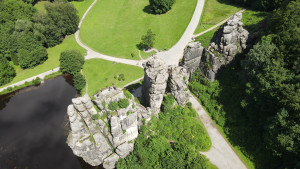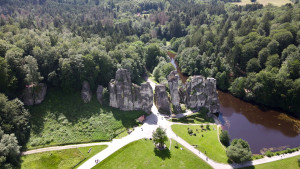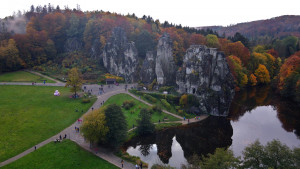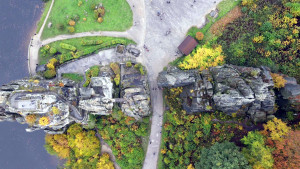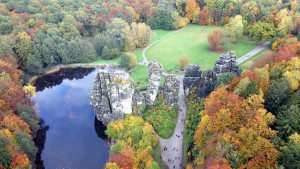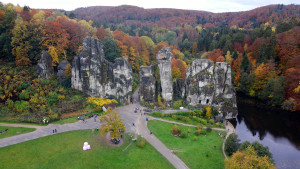TL;DR (too long; didn’t read)
The Externsteine are a group of spectacular sandstone rocks located within the Teutoburg Forest. The rocks were formed from sediment that accumulated within a marine basin many millions of years ago, which after burial and lithification were tectonically uplifted and tilted. People have visited the rocks for many hundreds of years and they are regarded as a place of worship. Humans have now changed the appearance of the rocks by building bridges and stairs. There are also artificial caves and carvings.
The mystical Externsteine
The monumental Externsteine of the Teutoburg Forest consists of 13 rugged sandstone rock columns that reach up to 40 m in height (Welle, 2020). The unique nature of this cultural monument is located near Horn-Bad Meinberg in North Rhine-Westfalia and is a popular destination due to its scenic beauty and the numerous myths surrounding the rock formation (Linde, 2019). The Externsteine are found in a nature reserve covering 127 ha and as a result, present a protected ground monument. The old path passing through the rock formation was expanded to a road in 1813. Between 1912 and 1953 a tramway crossed the formation, first as a shuttle operation and later for touristic purposes.
In 1940 the area was declared a recreational area and since 2005 the area was designated a special area of conservation. In 2006 the Externsteine was also awarded the title National Geosite. Between half a million and a million people visit the Externsteine each year.
The rocks show signs of anthropogenic influence. There are sculptured stone reliefs, stairs and caves incorporated into the rock formation. Some of the rocks are walkable by steps and bridges. From a scientific point of view, the installations are largely interpreted as relics from the Christian Middle Ages (Linde, 2019). In the 1920s and 1930s, the Externsteine was depicted as a pre-Christian cult site by nationalists and Nazis. The rock formation is therefore still a symbolic site of right-wing groups. The site also attracts esoteric and neo-pagan groups, that cannot be assigned to the right-wing (Linde, 2019). But especially from a geological point of view, the vertical sandstone layers are fascinating. The formation and importance of this unique rock formation are presented and explained in the nearby information centre.
Formation of the Externsteine
The Externsteine of the Teutoburg Forst, near Detmold, is one of the most remarkable examples of the Lower Cretaceous sedimentary strata of Osning-Sandstone. Osning is an old term for the Teutoburg Forest and the Egge Hills (Lower Saxon Hills or Eggegebirge) (Meschede, 2018).
The Osning-Sandstone formed during the Lower Cretaceous (probably Albian) with the deposition of sand along the northeastern coastal region of the Münsterland Cretaceous Basin (Farrenschon, 1990). The sediments accumulated over a couple of million years during several transgressive and regressive periods of the sea level and the coastline. Estuary-, beach-, tidal flat and shelf sands were deposited. The different sedimentary facies (depositional environments) occur next to and on top of each other (Speetzen, 2010).
The strata of the Osning-Sandstone in Lower Saxony and East-Westfalia generally have a shallow dip towards the W or SW. In the area of the Externsteine, they are oriented in a vertical position and overlie Keuper (Upper Triassic) and Lias (Lower Jura) strata. These older rocks are also preserved in tectonic graben structures. The tectonic evolution started earlier on during the Jurassic period when the rocks were faulted and fractured into blocks (Böse, Ehlers & Lehmkuhl, 2017). The main phase of tectonic activity occurred at the end of the Mesozoic in the Upper Cretaceous period. This can be deduced from the faulted and in some instances steeply tilted Lower Cretaceous strata of the Grotenburg-block, which are characteristic features of the Osning-Sandstone of the Externsteine (Drozdzewski & Dölling, 2018). The spectacular tilting of the rock formation is the result of tectonic forces. The classical interpretation is that it was related to deformation associated with the collision of the Alps with Europe. However, Kley & Voigt (2008) showed that changes in the direction of movement of the African plate were responsible for the observed deformation. One of the most important fault zones is the Osning fault zone. It divides the Lower Saxony Basin in the N from the Münsterland Cretaceous Basin in the S (Fig. 1).

The northern block was thrust upon the southern block, which caused rock strata to be tilted vertically or even overturned. Furthermore, the Osning fault represents the boundary between the Rhenish Massif and the Lower Saxony Basin and the Lower Saxon Tectogene (Farrenschon, 1990; Drozdzewski & Dölling, 2018).
There are different interpretations of the Osning fault zone. Traditionally it is regarded as a series of northward dipping step faults, that were rotated into south-verging normal and reverse faults during the Upper Cretaceous without the involvement of transform faulting (Baldschuhn & Kockel, 1999; Sippel, 2009, Kley, 2013). More recent studies postulate the influence of transform faults affecting the fault zone (Drozdzewski & Dölling, 2018). Regionally the Externsteine forms part of the Berlebeck-axis of the Osning fault zone (Drozdzewski & Dölling, 2018) (Fig. 1).
The Externsteine nowadays
Today’s appearance of the Externsteine is mainly attributed to erosion. Erosive processes led to different surface shapes such as plateaus, cuestas or hogbacks– depending on the hardness of the rocks of the Mesozoic cap rock and the dip of the strata (Fig. 2). This rock-specific spatial variation in geomorphology is caused by differential weathering and erosion of the different geological strata (Böse, Ehlers & Lehmkuhl, 2017). The properties of the subsurface such as water permeability, rock strength, resistance to weathering cause the differences between the layers. Subsequently, high precipitation rates and tropical temperatures further facilitated intense weathering (Farrenschon, 1990).

Topographically, the area of the Teutoburg Forest, which includes the Externsteine, form a hogback structural landscape. This forms as the steeply dipping hard strata form prominent ridges that cross the landscape (Fig. 3). Due to siliceous cementation, the strata are particularly hard and resistant to erosion. There are the rocks that give rise to the 13 rock columns of the Externsteine that are exposed by erosion. The Externsteine are aligned in an NW-SE direction. When approaching from the visitor path from the W, the youngest strata is encountered first. Along the fractures, there is characteristic spherical weathering (Meschede, 2018). As previously mentioned, there are several anthropogenic features in the natural rock formations that shape the appearance of the Externsteine.

3D-Models
Impressions
References
Ahnert, F. (2015): Einführung in die Geomorphologie. UTB GmbH.
Baldschuhn, R. & Kockel, F. (1999): Das Osning-Lineament am Südrand des Niedersachsen-Beckens. – Z. dt. geol. Ges., 150 (4): 673-695. Stuttgart.
Böse, M., Ehlers, J., & Lehmkuhl, F. (2017): Der Mittelgebirgsrand. Deutschlands Norden, 51–70. doi:10.1007/978-3-662-55373-2_4.
Drozdzewski, G. & Dölling, M. (2018): Elemente der Osning-Störungszone (NW-Deutschland) Leitstrukturen einer Blattverschiebungszone. – Scriptum online 7, 39 S., Krefeld.
Farrenschon, J. (1990): Erläuterungen zu Blatt 4119 Horn-Bad Meinberg. – Geol. Kt. Nordrh.-Westf. 1:25 000, Erl., 4119, 2. Aufl.: 195 S., 13 Abb., 13 Tab., 1 Taf.; Krefeld.
Kley, J. (2013): Saxonische Tektonik im 21. Jahrhundert. – Z. dt. Ges. Geowiss., 164: 295-311. Stuttgart.
Kley, J., & Voigt, T. (2008). Late Cretaceous intraplate thrusting in central Europe: Effect of Africa-Iberia-Europe convergence, not Alpine collision. Geology, 36(11), 839-842.
Linde, R. (2019): Die Externsteine – Ein Natur- und Kulturdenkmal im Spannungsfeld von Esoterik, Neuheidentum und Wissenschaft.
Meschede, M. (2018): Geologie Deutschlands. Ein prozessorientierter Ansatz, Springer, 2. Auflage.
Sippel, J. (2009): The Paleostress History of the Central European Basin System- Sci. techn. Rep. STR09/06, GFZ Potsdam: 149 S. Potsdam.
Speetzen, E. (2010): Osning-Sandstein und Gault-Sandstein (Unterkreide) aus dem Teutoburger Wald und dem Eggegebirge und ihre Verwendung als Naturbausteine. – Geologie und Paläontologie in Westfalen 77, 59 S.
Welle, F. (2020, 14. März): Märchenhafte Felsen. Externsteine. Süddeutsche Zeitung. https://www.sueddeutsche.de/politik/externsteine-teutoburger-wald-1.4841882.



